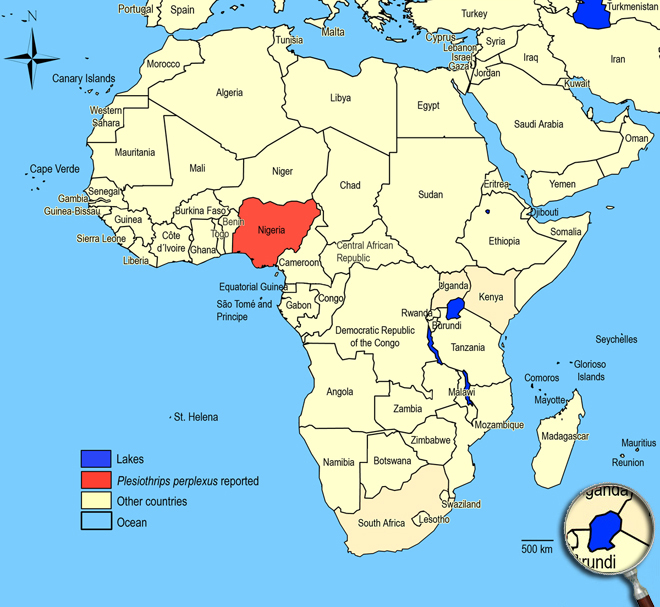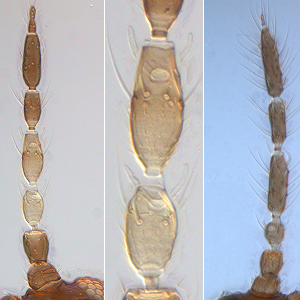Plesiothrips perplexus (Beach, 1896)
Thripinae, Thripidae, Terebrantia, Thysanoptera
Figures
Fig. 1: 7-segmented antenna, segments III and IV with forked sense cone (female), 7-segmented antenna (male)
Fig. 2: Head dorsal with ocellar triangle
Fig. 3: Pronotum
Fig. 4: Meso- and metanotum
Fig. 5: Fore- and hind wing, fore wing distal region
Fig. 6: Meso- and metasternum
Fig. 7: Sternites VI and VII
Fig. 8: Tergites VII-IX
Fig. 9: Tergites VIII-XI
Introduction and recognition
Plesiothrips perplexus develops within florets of several grasses like maize, rice, and sugarcane. Both sexes macropterous. Body typically bicolored with head and thorax brown but abdomen light brown or yellow with apex dark; legs and antennal segments III & IV yellow; fore wings light brown with basal quarter clear. Antennae 7-segmented; segments III & IV with sense cone forked, IV longer than III with apex produced into a neck, segment I with a pair of small dorso-apical setae (Fig. 1). Head longer than wide and projecting in front of eyes; 2 pairs of ocellar setae present, setae I absent, setae III about as long as side of ocellar triangle and arise just in front of hind ocelli within ocellar triangle; postocular setae small (Fig. 2). Pronotum with 2 pairs of long posteroangular setae; posterior margin with 3 pairs of small setae (Fig. 3). Metanotum with scarcely equiangular reticulation or no sculpture medially; median setae small and arising well behind anterior margin; campaniform sensilla absent (Fig. 4). Mesofurca with spinula (Fig. 6). Mid and hind tarsi 2-segmented. Fore wing first vein with 8-13 setae, and then 2 setae near wing apex; second vein with a complete row of about 10 setae (Fig. 5). Tergites without sculpture medially; usually without ctenidia, but rudimentary ctenidia sometimes present on VI & VII; tergite VIII posterior margin with a few small microtrichia laterally; ovipositor valves very weak and without teeth (Fig. 8 and 9). Sternites without discal setae; median pair of marginal setae on sternite VII arise at posterior margin (Fig. 7).
Male similar to female but smaller; antennal segment III very small, IV-VI each with several rings of long setae, VII very small (Fig. 1); tergite IX posterior margin with 2 stout thorn-like setae each arising from prominent tubercle; sternites III & IV each with one pair of small circular glandular areas placed laterally.
Taxonomic identity
Species
Plesiothrips perplexus (Beach, 1896)
Taxonomic history
Thrips panicus Moulton, 1929
Sericothrips perplexus Beach, 1896
Common name
-
Present taxonomic position
Family: Thripidae Stephens, 1829
Subfamily: Thripinae (Stephens) Karny, 1921
Genus: Plesiothrips Hood, 1915
Genus description
The genus Plesiothrips Hood, 1915
Currently, 19 grass-living species are listed in this genus, all except one from the New World. The presence and position of the rudimentary ctenidia on tergites VI & VII, also the lack of ocellar setae I, suggest that this genus might be related to the genus Thrips. However, the presence of a pair of setae at the dorsal apex of antennal segment I, and the remarkable sexual dimorphism of the antennae, suggest that genus Plesiothrips is more likely to be only distantly related to the genus Thrips. Members of the genus have a weakly developed ovipositor and 7-segmented antennae with forked sense cone on segments III & IV. In females antennal segment III is smaller than IV, and in males segment III is very small but IV-VI are greatly enlarged (Mound & Kibby 1998; Mound & Marullo 1996).
Species description
Typical key character states of
Plesiothrips perplexus
Coloration and body sculpture
Body color: distinctively bicolored
Surface of head, pronotum and fore legs: without obvious or with weakly reticulate sculpture
Antennae
Number of antennal segments: 7
Antennal segment I: with pair of small setae on dorso-apical margin
Antennal segment II: without an exceptionally long seta at the inner apex
Antennal segment II shape: symmetric
Antennal segment III shape: symmetric
Form of sense cones on antennal segments III and IV: emergent and forked on segments III and IV
Length of antennal segment III and IV: antennal segment III is considerably shorter than segment IV
Antennal segment IV and V: with a hyaline ring near the base which separated off narrow darker ring
Forked sense cone on antennal segment IV: scarcely extending beyond base of segment V
Antennal segment VI bears: not a remarkably dagger-shaped sensorium
Head
Distance between bases of ocellar setae III: greater than width of first ocellus
Head: distinctly prolonged in front of compound eyes
Ocellar setae I: absent
Ocellar setae III: arising within ocellar triangle anterior to tangent of anterior margin of hind ocelli
Ocelli: present
Length of postocular setae: not alternating short and long setae
Number of ocellar setae: 2
Prothorax
Number of pairs of long anteroangular setae: 0
Number of pairs of long posteroangular setae: 2
Number of pairs of elongate pronotal setae: 2
Number of pairs of posteromarginal minor setae: 3
Pronotal blotch or internal apodeme: absent
Pronotum shape: broadly rectangular
Pronotum posteromarginal/posteroangular setae: S2 longer than S3, not equal in length
Mesothorax
Mesosternal furca: with median spinula
Metathorax
Metanotal campaniform sensilla: absent
Metanotal median setae: S1 behind anterior margin
Metanotum with dominant sculptured triangle medially: absent
Metasternal furca: without spinula
Shape of metathoracic furca: transverse, V-shaped
Sculpture of metanotum median area: with no sculpture medially or (rare) transverse at anterior, but equiangular reticulations on posterior half
Wings
Fore and hind wings: present, more than half as long as abdomen (macropterous)
Fringe cilia arising: from sockets
Fore wing veins: present
Fore- and hind wing surface: covered with microtrichia
Apex of fore wing: with prominent terminal setae
Fore wing anterior margin (costal vein): with setae and cilia but cilia longer than setae
Fore wing costal fringe cilia: arising at anterior margin of wing
Fore wing first vein: distinct from costal vein
Fore wing first vein setal row: incomplete, with setae not closely and uniformly spaced
Fore wing second vein setal row: complete, setae uniformly spaced
Fore wing shape: mainly parallel sided or margins run continuously towards each other
Fore wing surface: not reticulate
Fringe cilia on posterior margin near apex: distinctly wavy (undulated)
Length of fore wing costal setae at middle of wing: longer than half of median wing width
Shape of fore wing apex: with mainly posterior margin curved to join anterior margin
Fore wings: uniformly dark or shaded, but with base or sub-base pale
Legs
Fore tibia: not prolonged around fore tarsus
Mid and hind tarsi: with two segments
Color of fore tarsi: pale or yellow, sometimes apical shaded or brown
Abdomen
Pleurotergites: not covered in microtrichia
Sternite II: with marginal setae but no discal setae
Sternites IV, V and VI: with marginal setae but no discal setae
Sternite VII median posteromarginal setae S1: arising at posterior margin
Sternite VII: with marginal setae but no discal setae
Surface of lateral thirds of abdominal tergites: without regular rows of fine microtrichia
Tergites II to VII median setal pair: no more than 0.3 as long as median length of tergite
Craspedum on tergites IV to VI: absent
Tergites IV and V median setal pair: shorter than distance between their bases
Craspedum on tergite VIII: without craspedum medially and toothlike microtrichia laterally
Tergite VIII ctenidia: without paired ctenidia laterally, sometimes with irregular microtrichia
Tergite VIII posteromarginal comb of microtrichia: present laterally, incomplete medially
Tergite VIII
shape of posteromarginal microtrichia: short and irregular in length
Tergite X: not tubular, longitudinally incomplete
Setae on abdominal tergite X: all setae slender

Similar or related species
Compared to other species of Thripinae, in Plesiothrips perplexus antennal segment III is considerably shorter than segment IV. The species has an intermediate position between the complex of the genera Tenothrips and Megalurothrips which lacking tergal ctenidia on tergites V-VIII, and the Thrips, which have paired ctenidia laterally on tergites V-VIII. Plesiothrips perplexus has sometimes one pair of (even though only rudimentary and weakly developed) ctenidia on tergite VI & VII, but no ctenidia on tergite VIII. Like members of the genus Thrips, Plesiothrips perplexus has only 2 pairs of ocellar setae on the head (ocellar setae I absent), whereas species of Tenothrips and Megalurothrips have 3 pairs of ocellar setae. Plesiothrips perplexus as well as Tenothrips frici and Megalurothrips sjostedti have 2 pairs of elongate posteroangular setae, and tergite VIII posterior margin with a few short and irregular microtrichia only laterally. But compared to both other species with 8-segmented antennae, in Plesiothrips perplexus those are 7-segmented. As in Diarthrothrips coffeae, the species possesses antennal segments IV & V with a clear ring near the base which separated off narrow darker ring at the base, but Diarthrothrips coffeae has 8-segmented antennae, 3 pairs of ocellar steae, a metafurca with a well developed median spinula, and no comb of microtrichia on tergite VIII.
Biology
Life history
As with other thrips species the life cycle from egg to adult is dependent on temperature. The full cycle can take less than one week to over a month and adults may live for more than one month producing several generations in one year depending on seasonal weather (Lewis 1973).
Host plants
Various Poaceae including maize, rice and sugar cane.
Vector capacity
None identified, but possible mechanical distribution of phytopathogenic fungi and bacteria.
Damage and symptoms
-
Detection and control strategies
-
Additional notes
Breeding on grasses, the adult females have a very weak ovipositor that is probably not capable of inserting eggs into plant tissue. Presumably the eggs are deposited within the flowering heads of grasses and developing within grass florets.
Biogeography
Originally from the New World, this species is now widespread in tropical and sub-tropical countries. Nigeria.
African countries where Plesiothrips perplexus has been reported

The species Plesiothrips perplexus was not observed in surveys undertaken in East Africa on vegetables and associated weeds and crops.
Please click here for survey sites of all observed thrips species of Kenya, Tanzania and Uganda.

Bibliography
Beach AM (1896). Contribution to a knowledge of the Thripidae of Iowa. Proceedings of the Iowa Academy of Sciences. 3: 214-227
Hinds WE (1903). Contribution to a monograph of the insects of the order Thysanoptera inhabiting North America. Proceedings of the United States National Museum. 26 (1310): 79-242
Hood JD (1915). An interesting case of antennal antigeny in Thysanoptera. Proceedings of the Entomological Society of Washington. 17: 128-132
Karny H (1925). On some tropical Thysanoptera. Bulletin of Entomological Research. 16 (2): 125-142
Lewis T (1973). Thrips: their biology, ecology and economic importance. Academic Press Inc., London Ltd., 349 pp.
Moritz G, Morris DC & Mound LA (2001). ThripsID - Pest thrips of the world. ACIAR and CSIRO Publishing Collingwood, Victoria, Australia, CDROM ISBN 1 86320 296 X
Moritz G, Mound LA, Morris DC & Goldarazena A (2004). Pest thrips of the world - an identification and information system using molecular and microscopical methods. Centre for Biological Information Technology, University of Queensland, Australia, CDROM ISBN 1 86499 781 8
Moulton D (1929). New Thysanoptera from Cuba. Florida Entomologist. 13 (4): 61-66
Mound LA & Kibby G (1998). Thysanoptera: An identification guide, (2nd edition). CAB International, Wallingford and New York, 70 pp
Mound LA & Marullo R (1996). The thrips of Central and South America: An introduction (Insecta: Thysanoptera). Memoirs on Entomology, International, Vol. 6. Associated Publishers, Gainsville, 487 pp
Palmer JM, Mound LA & du Heaume GJ (1989). 2. Thysanoptera, 73 pp. In Betts CR [ed.], CIE Guides to insects of importance to man. CAB International, Wallingford, Oxon, UK
zur Strassen R (1983). Thysanopterologische Notizen (6) (Insecta: Thysanoptera). Senckenbergiana Biologica. 63 (3-4): 191-209
zur Strassen R (2003). Die terebranten Thysanopteren Europas und des Mittelmeer-Gebietes. Die Tierwelt Deutschlands und der angrenzenden Meeresteile nach ihren Merkmalen und nach ihrer Lebensweise, 74. Teil. Goecke & Evers, Keltern, Germany, 277 pp
----
Web links
Mound´s Thysanoptera pages
Thysanoptera Checklist
ICIPE Thrips survey sites
UNI Halle & Thrips sites
Thrips of California












